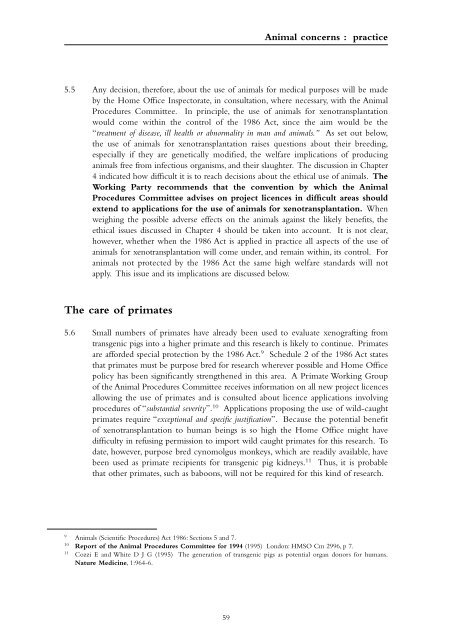Xenotransplantation - Nuffield Council on Bioethics
Xenotransplantation - Nuffield Council on Bioethics
Xenotransplantation - Nuffield Council on Bioethics
You also want an ePaper? Increase the reach of your titles
YUMPU automatically turns print PDFs into web optimized ePapers that Google loves.
Animal c<strong>on</strong>cerns : practice<br />
5.5 Any decisi<strong>on</strong>, therefore, about the use of animals for medical purposes will be made<br />
by the Home Office Inspectorate, in c<strong>on</strong>sultati<strong>on</strong>, where necessary, with the Animal<br />
Procedures Committee. In principle, the use of animals for xenotransplantati<strong>on</strong><br />
would come within the c<strong>on</strong>trol of the 1986 Act, since the aim would be the<br />
“treatment of disease, ill health or abnormality in man and animals.” As set out below,<br />
the use of animals for xenotransplantati<strong>on</strong> raises questi<strong>on</strong>s about their breeding,<br />
especially if they are genetically modified, the welfare implicati<strong>on</strong>s of producing<br />
animals free from infectious organisms, and their slaughter. The discussi<strong>on</strong> in Chapter<br />
4 indicated how difficult it is to reach decisi<strong>on</strong>s about the ethical use of animals. The<br />
Working Party recommends that the c<strong>on</strong>venti<strong>on</strong> by which the Animal<br />
Procedures Committee advises <strong>on</strong> project licences in difficult areas should<br />
extend to applicati<strong>on</strong>s for the use of animals for xenotransplantati<strong>on</strong>. When<br />
weighing the possible adverse effects <strong>on</strong> the animals against the likely benefits, the<br />
ethical issues discussed in Chapter 4 should be taken into account. It is not clear,<br />
however, whether when the 1986 Act is applied in practice all aspects of the use of<br />
animals for xenotransplantati<strong>on</strong> will come under, and remain within, its c<strong>on</strong>trol. For<br />
animals not protected by the 1986 Act the same high welfare standards will not<br />
apply. This issue and its implicati<strong>on</strong>s are discussed below.<br />
The care of primates<br />
5.6 Small numbers of primates have already been used to evaluate xenografting from<br />
transgenic pigs into a higher primate and this research is likely to c<strong>on</strong>tinue. Primates<br />
are afforded special protecti<strong>on</strong> by the 1986 Act. 9 Schedule 2 of the 1986 Act states<br />
that primates must be purpose bred for research wherever possible and Home Office<br />
policy has been significantly strengthened in this area. A Primate Working Group<br />
of the Animal Procedures Committee receives informati<strong>on</strong> <strong>on</strong> all new project licences<br />
allowing the use of primates and is c<strong>on</strong>sulted about licence applicati<strong>on</strong>s involving<br />
procedures of “substantial severity”. 10 Applicati<strong>on</strong>s proposing the use of wild-caught<br />
primates require “excepti<strong>on</strong>al and specific justificati<strong>on</strong>”. Because the potential benefit<br />
of xenotransplantati<strong>on</strong> to human beings is so high the Home Office might have<br />
difficulty in refusing permissi<strong>on</strong> to import wild caught primates for this research. To<br />
date, however, purpose bred cynomolgus m<strong>on</strong>keys, which are readily available, have<br />
been used as primate recipients for transgenic pig kidneys. 11 Thus, it is probable<br />
that other primates, such as babo<strong>on</strong>s, will not be required for this kind of research.<br />
9<br />
Animals (Scientific Procedures) Act 1986: Secti<strong>on</strong>s 5 and 7.<br />
10<br />
Report of the Animal Procedures Committee for 1994 (1995) L<strong>on</strong>d<strong>on</strong>: HMSO Cm 2996, p 7.<br />
11<br />
Cozzi E and White D J G (1995) The generati<strong>on</strong> of transgenic pigs as potential organ d<strong>on</strong>ors for humans.<br />
Nature Medicine, 1:964-6.<br />
59
















